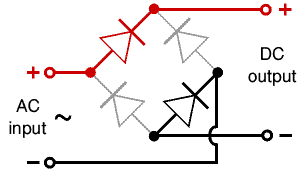
Diodes allow electricity to flow in only one direction, but there is a small voltage lost across the a diode of 0.7V called the forward voltage drop. If the diode is wired in the wrong direction then no current (actually a very tiny current) flows across the diode. However, if the voltage is too high and goes over the diode's maximum reverse voltage, the diode will breakdown and fail.
If you would like to make your own bridge rectifier then the 1N4001 diode is perfect for most low voltage circuits where the current is less than 1A. The 1N5401 diode is used where the maximum current is 3A. They are extremely cheap at just a couple of pounds for a hundred on eBay. Click here for instructions on making your own bridge rectifier from diodes.

No comments:
Post a Comment